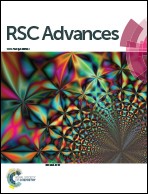Preparation of copper doped magnetic porous carbon for removal of methylene blue by a heterogeneous Fenton-like reaction†
Abstract
High-specific-surface-area copper doped magnetic porous carbon (CuFe2O4/Cu@C) was fabricated by annealing iron, copper and 1,3,5-benzenetricarboxylic ([Cu/Fe]-BTC) metal–organic coordination polymers, which were prepared via a one-pot solvothermal method. The novel CuFe2O4/Cu@C catalyst consists of Cu (3.80%), CuFe2O4 (64.84%), and C (31.36%). Scanning electron microscopy, X-ray diffraction, X-ray photoelectron spectroscopy, elemental analysis, inductively coupled plasma, Brunauer–Emmett–Teller surface area measurement, and vibrating sample magnetometer analysis were used to characterize the materials. The as-prepared materials were employed as a heterogeneous Fenton’s reagent with the addition of H2O2 for degradation of methylene blue (MB). The results showed that the materials effectively catalyzed H2O2 to generate hydroxyl radicals (˙OH). And due to their magnetism, the materials can be easily separated from wastewater to achieve repeatability. It also turned out that CuFe2O4/Cu@C had a higher catalytic activity than Fe3O4@C, which proved the importance of copper doped into the catalyst. This work indicated that porous carbon composites provide good support for the development of a highly efficient heterogeneous Fenton catalyst, which is useful for environmental pollution cleanup.


 Please wait while we load your content...
Please wait while we load your content...